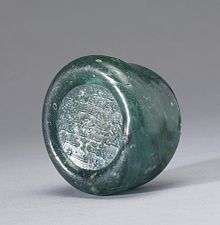Coin weights
Coin weights are weights which were designed to weigh coins in order to assure their quality.[1]

The usage of coin weights, especially glass ones, goes back to Ptolemaic and Byzantine times.[1] Coin weights were also known in Ancient China.[2]
In Islamic civilization, where they are called Sanadjāt, coin weights are said to have been introduced by a Jew named Sumair in 694.[1] Up to that point coins were only compared to coins of good quality.[1] Islamic coin weights were made of bronze, iron, and later glass (considered to be unalterable).[1] They bear inscriptions related to Islamic rulers and moneyers and are therefore valuable epigraphical objects.[1]
Coins weights were also known in the Carolingian Empire, where they were stamped with regular coin dyes to clarify their attribution.[3] Islamic coin weights were introduced to Great Britain in the 9-10th century CE through the Vikings.[4]
Notes
- Arnold, T.W. (1987). Houtsma, M. Th (ed.). E.J. Brill's first encyclopaedia of Islam, 1913-1936. Brill. p. 195. ISBN 9789004082656.
- Scheidel, Walter (5 February 2009). Rome and China: Comparative Perspectives on Ancient World Empires. Oxford University Press. p. 144. ISBN 9780199714292.
- Coupland, Simon (2007). Carolingian Coinage and the Vikings: Studies on Power and Trade in the 9th Century. Ashgate Publishing, Ltd. p. 38. ISBN 9780860789918.
- "Department of Coins and Medals". British Museum exhibit. Trustees of the British Museum. Retrieved 3 August 2019.
| Wikimedia Commons has media related to Coin weights. |